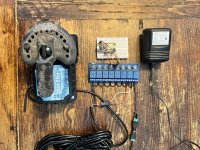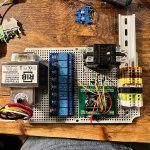TL;DR Use Shelly relay's to automate the pool timer and swg autooff if pump is off. Also use home assistant to check if there is air in the pump using power monitoring. This is not a full how-to, just an overview.
Last year I put up a 21' AGP. When I running my electrical, I wanted an easy way to schedule my pump and SWG. There are a million smart plugs out there, but it seemed like Home | Shelly Cloud were some of the best for compatibility and security (you don't need to use there cloud if you don't want). I've been very happy with the result.
What I am doing with shelly:
- Turn on my pump and SWG remotely (in my house, at work, wherever)
- Schedule my pump and SWG
- Set timers on my SWG and pump
- view on-off logs to see when it ran
Basic Equipment:
- 2 shelly 1pm's Shelly 1PM | Shelly Cloud
- 2 standard paddle switches
- Modification: I converted a couple paddle switches to momentary switches using this video:
- All wiring and gang boxes needed for exterior use.
Some simple automations using Shelly "Scenes"
- Turn off SWG if the pump is turned off
- Turn on the pump if the SWG is turned on.
Advanced - Problem and solution
This is my second season with the pool and I have an air leak on the intake side. Its not a bad leak and only shows itself if the skimmer is getting clogged (I use hair nets in the skimmer which can get clogged). I would also find kids toys stuck in the skimmer flap. I kept finding my pump running dry... not good.
Since I bought the Shelly 1pm's, they have power monitoring. When my pump is running on high it pulls about 975-1013 watts. If its on low, it pulls around 200 watts.
I realized that when there is air in the pump, the wattage drops quite a bit. On high it will drop below 900 watts, on low it will drop below 190 watts.
Shelly doesn't look like they have a great way to do this in their "scenes" so I installed a program called Home Assistant. I'd never used it before but had a file server running in my basement and just installed it right there.
Home assistant detected and added my shelly's instantly. It was super easy and required zero coding, I could do it all in the web interface.
My simple automation - Detect water in the pump, turn it off and notify me:
When the pump is on high speed -
- Trigger: pump power is <900w for at least 30 sec.
- Condition: if pump power is >500w (this is so it doesn't trigger when the pump is in low speed mode) & the pump is on
- action: turn off the pump & notify me with notify.notify (this is basically just the android app). This will notify me and my wife.
When the pump is on low speed-
- Trigger: pump power is <195w for at least 30 sec.
- Condition: if pump power is >1w & the pump is on
- action: turn off the pump & notify me with notify.notify (this is basically just the android app). This will notify me and my wife.
Conclusion:
I'm very happy with my simple low effort solution. It didn't take a lot of time and it runs perfectly.
In the future I'm going to add a thermometer to one of the shelly's and setup home assistant to do temperature logging of my pool water into a google sheet. I want to better understand how the pool temps fluctuate with outdoor temps
Last year I put up a 21' AGP. When I running my electrical, I wanted an easy way to schedule my pump and SWG. There are a million smart plugs out there, but it seemed like Home | Shelly Cloud were some of the best for compatibility and security (you don't need to use there cloud if you don't want). I've been very happy with the result.
What I am doing with shelly:
- Turn on my pump and SWG remotely (in my house, at work, wherever)
- Schedule my pump and SWG
- Set timers on my SWG and pump
- view on-off logs to see when it ran
Basic Equipment:
- 2 shelly 1pm's Shelly 1PM | Shelly Cloud
- 2 standard paddle switches
- Modification: I converted a couple paddle switches to momentary switches using this video:
Some simple automations using Shelly "Scenes"
- Turn off SWG if the pump is turned off
- Turn on the pump if the SWG is turned on.
Advanced - Problem and solution
This is my second season with the pool and I have an air leak on the intake side. Its not a bad leak and only shows itself if the skimmer is getting clogged (I use hair nets in the skimmer which can get clogged). I would also find kids toys stuck in the skimmer flap. I kept finding my pump running dry... not good.
Since I bought the Shelly 1pm's, they have power monitoring. When my pump is running on high it pulls about 975-1013 watts. If its on low, it pulls around 200 watts.
I realized that when there is air in the pump, the wattage drops quite a bit. On high it will drop below 900 watts, on low it will drop below 190 watts.
Shelly doesn't look like they have a great way to do this in their "scenes" so I installed a program called Home Assistant. I'd never used it before but had a file server running in my basement and just installed it right there.
Home assistant detected and added my shelly's instantly. It was super easy and required zero coding, I could do it all in the web interface.
My simple automation - Detect water in the pump, turn it off and notify me:
When the pump is on high speed -
- Trigger: pump power is <900w for at least 30 sec.
- Condition: if pump power is >500w (this is so it doesn't trigger when the pump is in low speed mode) & the pump is on
- action: turn off the pump & notify me with notify.notify (this is basically just the android app). This will notify me and my wife.
When the pump is on low speed-
- Trigger: pump power is <195w for at least 30 sec.
- Condition: if pump power is >1w & the pump is on
- action: turn off the pump & notify me with notify.notify (this is basically just the android app). This will notify me and my wife.
Conclusion:
I'm very happy with my simple low effort solution. It didn't take a lot of time and it runs perfectly.
In the future I'm going to add a thermometer to one of the shelly's and setup home assistant to do temperature logging of my pool water into a google sheet. I want to better understand how the pool temps fluctuate with outdoor temps



